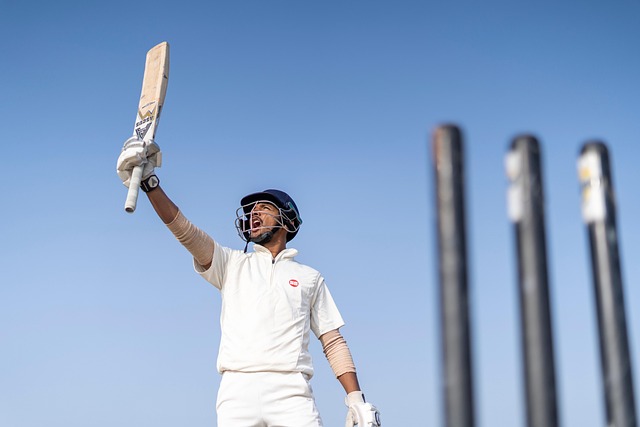"Tactical innovations in spin and pace bowling dominate West Indies vs Pakistan matches. Home advantage, passionate fan cultures, and strategic field placements impact outcomes. Captain's strategies, based on data and historical analysis, play a central role. Explore the intricate dance of tactical adjustments, influenced by cricket equipment and pitch characteristics, to understand these high-pressure encounters between powerhouses West Indies cricket team vs Pakistan."
In the dynamic world of cricket, tactical shifts can decide matches. This article explores common strategic changes during encounters between formidable teams, using the West Indies Cricket Team vs. Pakistan as a lens. From bowling strategies that can swing the game to batting lineup adjustments and field placement tactics for spinners and fast bowlers, we delve into crucial elements like time management under pressure. Understanding these shifts offers insights into the intricate dance of cricket strategy.
- Bowling Strategies: West Indies vs Pakistan
- Batting Lineups: Adjustments and Counterattacks
- Field Placement Tactics: Managing Spinners and Fast Bowlers
- Strategic Time Management: Building Pressure in Innings
Bowling Strategies: West Indies vs Pakistan

The West Indies and Pakistan, both known for their rich cricket traditions, have delivered several captivating matches that showcase tactical variations. When these teams meet, strategic changes become pivotal, especially in the bowling department. One notable aspect is the contrast in spin bowling techniques. The West Indies often utilize the unique skills of their spinners, like the pinpoint accuracy and turn of the ball, to exploit Pakistan’s batting line-up, which has historically been vulnerable against such variations. In contrast, Pakistan relies on pace bowling, with fast bowlers like Shaheen Afridi and Hasan Ali, who can generate swing and pace, posing a direct challenge to West Indies’ batsmen.
The impact of home advantage on match outcomes is evident in these encounters. When the West Indies play on their familiar grounds, they gain a psychological edge that translates into improved performance. This familiarity with conditions allows them to make tactical adjustments swiftly, as seen in recent successes against Pakistan. Moreover, comparing cricket fan cultures between West Indies and Pakistan reveals a passionate dedication that fuels team psychology. Building mental fortitude is key; both teams must prepare mentally to overcome the pressure and expectations of their supportive fans. Visit us at [website] to explore more insights into the key factors contributing to West Indies’ recent success against Pakistan, highlighting the dynamic interplay between tactical changes, home advantage, and cricket team psychology.
Batting Lineups: Adjustments and Counterattacks

In a high-pressure cricket match, like those between the West Indies and Pakistan, tactical adjustments are key to turning the tide. Batting lineups play a pivotal role in this, as teams constantly evaluate their strengths and weaknesses against their opponents’ bowling attacks. For instance, if facing a formidable West Indies fast bowling attack, Pakistan might opt for a more defensive batting approach initially, looking to build a solid foundation before launching counterattacks later on. This strategy often involves selecting players who are adept at handling short-pitched deliveries and maintaining discipline in the face of intense bowling pressure.
The West Indies captain’s strategy against Pakistan’s batting line-up can significantly impact the course of the game. They might employ various tactics, such as varying the pace and length of deliveries to disrupt the batters’ rhythm or target specific weaknesses identified through historical data analysis—a key aspect in cricket match predictions. For example, if Pakistan has a history of struggling against carrom ball bowlers, the West Indies might introduce spin early on, aiming to exploit this known vulnerability. Visit us at comparing cricket fan cultures: West Indies and Pakistan anytime to understand how these tactical decisions shape the narrative of these intense cricket encounters.
Field Placement Tactics: Managing Spinners and Fast Bowlers

In cricket matches, such as those between the West Indies and Pakistan, tactical changes are pivotal to gaining an edge over the opponent. Field placement tactics, particularly when managing spinners and fast bowlers, can significantly influence the outcome of a game. During the match, coaches often employ strategic positioning to maximise the strengths of their bowlers. For instance, in the West Indies vs Pakistan games, we’ve witnessed effective use of the “long-on” and “deep mid-wicket” positions for spinners to trap batsmen on the crease. This contrast with fast bowlers is crucial, as they benefit from the “point” or “cover” areas, where their pace and swing can cause maximum disruption.
The strategic analysis of West Indies batting against Pakistan’s bowling attack would reveal a fascinating interplay of these tactics. The West Indies team may choose to place more fielders in the circle during Pakistan’s bowling spells, aiming to restrict scoring opportunities. Conversely, when the West Indies bowl, they might opt for a more aggressive field setup to pressurise the Pakistani batsmen. These tactical adjustments are not just about placement; they also consider cricket equipment and its impact on performance. For example, the type of ball used—a new, hard one that generates more bounce or an older one that’s slightly worn—can dictate bowling strategies. Engaging in these strategic shifts requires a deep understanding of both teams’ playing styles, which is why comparing cricket coaching styles: West Indies vs Pakistan can offer valuable insights for fans and analysts alike. To gain a deeper perspective, give us a call at cricket fan engagement strategies for West Indies vs Pakistan matches; our experts can guide you through the intricate tactical changes that make these games so captivating.
Strategic Time Management: Building Pressure in Innings

In cricket, strategic time management is an art that can turn the tide of a match. During innings, teams often employ tactical changes to build pressure on their opponents, especially when chasing a target or trying to defend a total. One notable example involves the West Indies cricket team vs Pakistan, where the Caribbean side has historically utilized clever field placements and bowling changes at strategic intervals to restrict the flow of runs. By varying the pace of the game, they can create moments of intense pressure, forcing the opposition into making mistakes under time constraints.
The iconic cricket matches between West Indies and Pakistan have often showcased this tactical prowess. Over time, as statistical comparisons reveal, the tactical differences between Caribbean and Pakistani pitches have influenced gameplay. The tactile variations in these venues play a significant role in decision-making, encouraging teams to adapt their strategies accordingly. To truly understand these nuances, consider visiting us at the historical significance of Test matches between West Indies and Pakistan anytime—a journey through cricket’s rich tapestry will provide insights into how these tactical changes have shaped the sport over the years.
In matches between strong contenders like the West Indies cricket team vs Pakistan, tactical flexibility is key. From bowling strategies that leverage both spinners and fast bowlers to dynamic batting lineup adjustments and precise field placement tactics, every move counts. Effective strategic time management adds pressure, creating opportunities for buildup and counterattack. Understanding these common tactical changes offers insights into how teams navigate complex situations, ultimately shaping the outcome of high-stakes games.







Leave a Reply